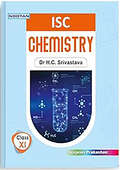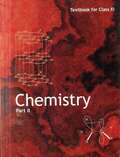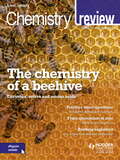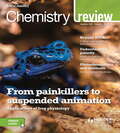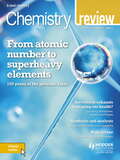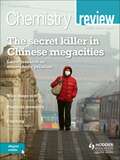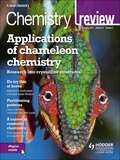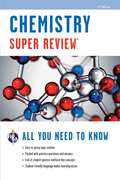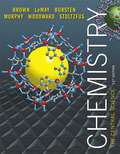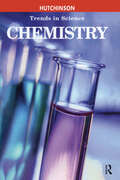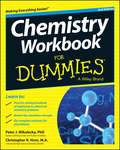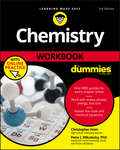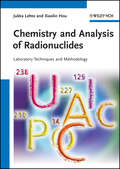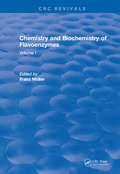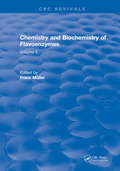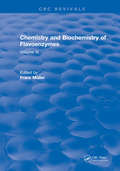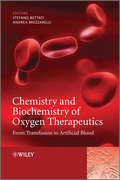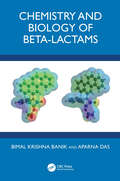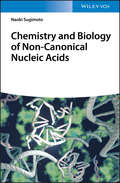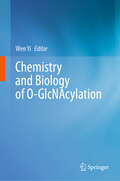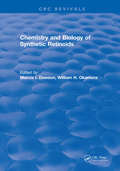- Table View
- List View
Chemistry Part-2 class 11 - ISC
by Dr H. C. SrivastavaComputer Fundamentals: Nootan ISC Chemistry for Class XI has been thoroughly revised and restructured in the light of the latest syllabus and the detailed scope of the syllabus issued by the Council for Indian School Certificate Examination, New Delhi. Si
Chemistry Part-2 class 11 - NCERT - 23
by National Council of Educational Research and TrainingIn "Chemistry Part 2" for class 11, Unit 7 delves into Redox Reactions, presenting classical oxidation-reduction concepts and electron transfer dynamics. The unit also introduces oxidation numbers and their link to electrode processes. Transitioning to Organic Chemistry in Unit 8, readers explore the unique tetravalence of carbon, varied organic compound structures, and their classification. The unit demystifies organic compound nomenclature, introduces isomerism, and delves into organic reaction mechanisms. Techniques for purifying and analyzing organic compounds are discussed, encompassing both qualitative and quantitative approaches. Unit 9, centered on Hydrocarbons, classifies them as alkanes, alkenes, alkynes, and aromatic types, concluding with a note on certain hydrocarbons' carcinogenicity and toxicity.
Chemistry Review Magazine Volume 28, 2018/19 Issue 1
by Philip Allan MagazinesThis A-level chemistry magazine provides up-to-date articles specially written for students to help them gain the highest grade. Articles feature real-world applications of chemistry and signpost how these link with the exam. Chemistry Review also contains specific features on practical skills and on approaching exam questions.ContentsBreath of life Animal chemistry: Bees, honey and venom Drugs and dyes Did you know? Photoswitching isomers In pictures: Elements of smartphones Answer back: Polymers and azo dyes Revision note: The continuum of bonding Worth reading: The Disappearing Spoon Focus on industry: Extracting oil and gas Wonders of chemistry: Solar power: nature does it better Back page: Conservation and cyclododecane
Chemistry Review Magazine Volume 28, 2018/19 Issue 2
by Philip Allan MagazinesContentsHow clean is our air?Revision note: Disentangling polarityAnimal chemistry: Frogs and toadsIn pictures: Flying over firesWhat's your poison?Chemistry in medicine: Photochemistry and drug synthesisFocus on industry: What happens in an oil refinery?How science works: Investigating the structure of nucleic acidsSpectroscopy of space
Chemistry Review Magazine Volume 28, 2018/19 Issue 3
by Philip Allan MagazinesCONTENTSAre vehicle exhaust fumes damaging our health?Answer back: Synthesis and analysisAnimal chemistry: Cats and dogsIn pictures: Periodic table completed?Wonders of chemistry: Elements old and newWorth reading: Periodic Tales: the Curious Lives of the ElementsValuable vanillaMaking and doing: Systematic namesFocus on industry: Cracking and related refinery processesDid you know? Knock knock...Valentine chemistry
Chemistry Review Magazine Volume 28, 2018/19 issue 4
by Philip Allan MagazinesOrganic nitrogen: the secret killer in Chinese megacitiesFocus on industry: FrackingEncounter: Chemistry with altitudeWorth reading: The Private Life of AtomsIn pictures: What shape is my molecule?Phosphorus: the essential elementHow science works: The future of the periodic tableAnimal chemistry: SpidersLab page: Constructing an electrochemical cellIndex to Volume 28Back page: The chemistry of coral bleaching
Chemistry Review Magazine Volume 29, 2019/20 Issue 1
by Hodder Education MagazinesIs vaping really safer than smoking?How science works: EnergyA brief history of... Atomic structure: part 1Making and doing: Scrambled scientistsIn pictures: Cave chemistryCantharidin: from aphrodisiac to cancer cureAnswer back: Concentrate of sulfuric acidMaking and doing: Chemistry in knotsDid you know? Scrambled scientistsFocus on industry: AluminiumRadical clean-up
Chemistry Review Magazine Volume 29, 2019/20 Issue 2
by Hodder Education MagazinesPartitioning proteins: the blobs that won a Nobel prizeWonders of chemistry: Chameleon colour changesWhere would we be without chlorine?Encounter: The elephant in the labIn pictures: The elephant's toothpaste experimentLab page: Analysing limescale remover by acid-base titrationA brief history of... Atomic structure: part 2Focus on industry: IronCareers in chemistry: Cosmetic scientistBack page: Endangered elements
Chemistry Super Review - 2nd Ed. (Super Reviews Study Guides)
by Editors of REAREA's Chemistry Super ReviewGet all you need to know with Super Reviews!2nd EditionREA's Chemistry Super Review contains an in-depth review that explains everything high school and college students need to know about the subject. Written in an easy-to-read format, this study guide is an excellent refresher and helps students grasp the important elements quickly and effectively.Our Chemistry Super Review can be used as a companion to high school and college textbooks, or as a handy resource for anyone who wants to improve their chemistry skills and needs a fast review of the subject.Presented in a straightforward style, our review covers the material taught in a beginning-level chemistry course, including: atomic structure, bonding, chemical reactions, liquids, solids, gases, properties of solutions, chemical thermodynamics, and more. The book contains questions and answers to help reinforce what students learned from the review. Quizzes on each topic help students increase their knowledge and understanding and target areas where they need extra review and practice.
Chemistry The Central Science 13th ed
by The Editors at the PearsonThe trusted, innovative, calibrated leader–now tightly–integrated with MasteringChemistry® .<P> Unrivaled problems, notable scientific accuracy and currency, and remarkable clarity have made Chemistry: The Central Science the leading general chemistry text for more than a decade. Trusted, innovative, and calibrated, the text increases conceptual understanding and student success in general chemistry by building on the expertise of the dynamic author team of leading researchers and award-winning professors.<P> The new Thirteenth Edition builds on the Twelfth Edition’s major revision, in which every word and piece of art was scrutinized by all the authors to increase its effectiveness. Placing a greater emphasis on research, this edition is more tightly integrated with MasteringChemistry, the leading online homework, tutorial, and assessment program— resulting in an unparalleled teaching and learning package that personalizes learning and coaches students toward understanding and mastery of tough chemistry topics.<P> This program presents a better teaching and learning experience—for you and your students. It provides:<P> Superior support beyond the classroom with MasteringChemistry: Students benefit from personalized, interactive learning through MasteringChemistry’s self-paced tutorials that guide them through the text’s most challenging topics; provide immediate, specific feedback; and keep students engaged and on track.<P> Enhanced learning from a dynamic author team of leading researchers and award-winning professors: Each member of this well-respected author team brings their expertise in a wide range of areas to the pages of this popular text. All authors have been active researchers and have taught general chemistry for many years. <P> Improved conceptual understanding through stepped up, relevant pedagogy: Students get numerous opportunities to test their knowledge through Give It Some Thought (GIST) exercises, Go Figure questions, and A Closer Look essays, now integrated with clicker questions and in MasteringChemistry.<P> Invaluable aids that ensure problem-solving success: By using a consistent process, a unique Analyze/Plan/Solve/Check format, dual-column problem-solving approach in certain areas, a new practice exercise following each worked example, and the Strategies in Chemistry feature, students are placed on the right path from the very start to excel at problem solving and comprehension.<P> Clarity through visualization from a variety of perspectives, including macroscopic, microscopic, and symbolic: Included are Visualizing Concepts exercises, with models, graphs, and other visual materials; sample exercises with molecular illustrations; and conceptual questions in the end-of-chapter questions.
Chemistry Trends (Trends in Science)
by Keith B HuttonToday's fast-moving world of science will have far-reaching effects on all of our lives. Trends in Science is a series of of essential readings for anyone who wants to know more about how his or her future will be affected; as well, the series provides accessible and stimulating material for high school and college students, for researchers and librarians. All titles in the series provide: an introductory overview of the field in the last 100 years, reviewing the past but also predicting the new developments of the future; a detailed chronology of the most important milestones; an index of key terms and concepts; biographies of the most important scientists in each field and their role in shaping their particular branch of science; a listing of important Websites, a directory of organizations, and suggestions for further reading.
Chemistry Volume-1 class 12 - Tamil Nadu Board
by State Council of Educational Research and TrainingThe 12th Standard Chemistry Volume 1 textbook, published under the Tamil Nadu Free Textbook Programme, covers fundamental and advanced chemistry concepts essential for higher secondary students. It includes topics such as Metallurgy, p-Block Elements, Transition Elements, Coordination Chemistry, Solid State Chemistry, and Chemical Kinetics. The book emphasizes conceptual clarity with key features like example problems, self-evaluation exercises, and ICT-enabled learning resources. It provides insights into higher education and research opportunities in chemistry, along with information on entrance exams and scholarships. The book also highlights real-world applications of chemistry in metallurgy, material science, and industrial processes. Designed to develop analytical thinking and problem-solving skills, this comprehensive guide prepares students for academic and competitive exams.
Chemistry Workbook For Dummies
by Peter J. Mikulecky Chris HrenHundreds of practice problems to help you conquer chemistryAre you confounded by chemistry? Subject by subject, problem by problem, Chemistry Workbook For Dummies lends a helping hand so you can make sense of this often-intimidating subject. Packed with hundreds of practice problems that cover the gamut of everything you'll encounter in your introductory chemistry course, this hands-on guide will have you working your way through basic chemistry in no time.You can pick and choose the chapters and types of problems that challenge you the most, or you can work from cover to cover. With plenty of practice problems on everything from matter and molecules to moles and measurements, Chemistry Workbook For Dummies has everything you need to score higher in chemistry.Practice on hundreds of beginning-to-advanced chemistry problemsReview key chemistry conceptsGet complete answer explanations for all problemsFocus on the exact topics of a typical introductory chemistry courseIf you're a chemistry student who gets lost halfway through a problem or, worse yet, doesn't know where to begin, Chemistry Workbook For Dummies is packed with chemistry practice problems that will have you conquering chemistry in a flash!
Chemistry Workbook For Dummies
by Peter J. Mikulecky Chris HrenTake the confusion out of chemistry with hundreds of practice problems Chemistry Workbook For Dummies is your ultimate companion for introductory chemistry at the high school or college level. Packed with hundreds of practice problems, this workbook gives you the practice you need to internalize the essential concepts that form the foundations of chemistry. From matter and molecules to moles and measurements, these problems cover the full spectrum of topics you'll see in class—and each section includes key concept review and full explanations for every problem to quickly get you on the right track. This new third edition includes access to an online test bank, where you'll find bonus chapter quizzes to help you test your understanding and pinpoint areas in need of review. Whether you're preparing for an exam or seeking a start-to-finish study aid, this workbook is your ticket to acing basic chemistry. Chemistry problems can look intimidating; it's a whole new language, with different rules, new symbols, and complex concepts. The good news is that practice makes perfect, and this book provides plenty of it—with easy-to-understand coaching every step of the way. Delve deep into the parts of the periodic table Get comfortable with units, scientific notation, and chemical equations Work with states, phases, energy, and charges Master nomenclature, acids, bases, titrations, redox reactions, and more Understanding introductory chemistry is critical for your success in all science classes to follow; keeping up with the material now makes life much easier down the education road. Chemistry Workbook For Dummies gives you the practice you need to succeed!
Chemistry and Analysis of Radionuclides: Laboratory Techniques and Methodology
by Jukka Lehto Xiaolin HouWritten by chemists for chemists, this is a comprehensive guide to the important radionuclides as well as techniques for their separation and analysis. It introduces readers to the important laboratory techniques and methodologies in the field, providing practical instructions on how to handle nuclear waste and radioactivity in the environment.
Chemistry and Biochemistry of Flavoenzymes: Volume I
by Franz MullerChemistry and Biochemistry of Flavoenzymes summarizes the present knowledge of the chemical and physical properties of free flavin, modified flavins occurring in nature, and deazaflavin. This information forms the fundamental basis for understanding the catalytic properties of flavoenzymes. Flavoproteins involved in transport, electron transfer, oxidation, dehydrogenation and hydroxylation reactions are discussed with respect to their biochemical and biophysical properties. The book presents the catalytic mechanisms of the flavoproteins in detail and, where available, three-dimensional structures and molecular biology data are included. The medical aspects of free and protein-bound flavin are also briefly discussed. Chemistry and Biochemistry of Flavoenzymes is an essential reference source for chemists, biochemists, toxicologists, biologists, pharmacologists, and researchers in the pharmaceutical industry.
Chemistry and Biochemistry of Flavoenzymes: Volume II
by Franz MullerChemistry and Biochemistry of Flavoenzymes summarizes the present knowledge of the chemical and physical properties of free flavin, modified flavins occurring in nature, and deazaflavin. This information forms the fundamental basis for understanding the catalytic properties of flavoenzymes. Flavoproteins involved in transport, electron transfer, oxidation, dehydrogenation and hydroxylation reactions are discussed with respect to their biochemical and biophysical properties. The book presents the catalytic mechanisms of the flavoproteins in detail and, where available, three-dimensional structures and molecular biology data are included. The medical aspects of free and protein-bound flavin are also briefly discussed. Chemistry and Biochemistry of Flavoenzymes is an essential reference source for chemists, biochemists, toxicologists, biologists, pharmacologists, and researchers in the pharmaceutical industry.
Chemistry and Biochemistry of Flavoenzymes: Volume III
by Franz MullerChemistry and Biochemistry of Flavoenzymes summarizes the present knowledge of the chemical and physical properties of free flavin, modified flavins occurring in nature, and deazaflavin. This information forms the fundamental basis for understanding the catalytic properties of flavoenzymes. Flavoproteins involved in transport, electron transfer, oxidation, dehydrogenation and hydroxylation reactions are discussed with respect to their biochemical and biophysical properties. The book presents the catalytic mechanisms of the flavoproteins in detail and, where available, three-dimensional structures and molecular biology data are included. The medical aspects of free and protein-bound flavin are also briefly discussed. Chemistry and Biochemistry of Flavoenzymes is an essential reference source for chemists, biochemists, toxicologists, biologists, pharmacologists, and researchers in the pharmaceutical industry.
Chemistry and Biochemistry of Oxygen Therapeutics
by Stefano Bettati Andrea MozzarelliHuman blood performs many important functions including defence against disease and transport of biomolecules, but perhaps the most important is to carry oxygen - the fundamental biochemical fuel - and other blood gases around the cardiovascular system. Traditional therapies for the impairment of this function, or the rapid replacement of lost blood, have centred around blood transfusions. However scientists are developing chemicals (oxygen therapeutics, or "blood substitutes") which have the same oxygen-carrying capability as blood and can be used as replacements for blood transfusion or to treat diseases where oxygen transport is impaired.Chemistry and Biochemistry of Oxygen Therapeutics: From Transfusion to Artificial Blood links the underlying biochemical principles of the field with chemical and biotechnological innovations and pre-clinical development.The first part of the book deals with the chemistry, biochemistry, physiology and toxicity of oxygen, including chapters on hemoglobin reactivity and regulation; the major cellular and physiological control mechanisms of blood flow and oxygen delivery; hemoglobin and myoglobin; nitric oxide and oxygen; and the role of reactive oxygen and nitrogen species in ischemia/reperfusion Injury.The book then discusses medical needs for oxygen supply, including acute traumatic hemorrhage and anemia; diagnosis and treatment of haemorrhages in "non-surgical" patients; management of perioperative bleeding; oxygenation in the preterm neonate; ischemianormobaric and hyperbaric oxygen therapy for ischemic stroke and other neurological conditions; and transfusion therapy in β thalassemia and sickle cell diseaseFinally "old"and new strategies for oxygen supply are described. These include the political, administrative and logistic issues surrounding transfusion; conscientious objection in patient blood management; causes and consequences of red cell incompatibility; biochemistry of red blood cell storage; proteomic investigations on stored red blood cells; red blood cells from stem cells; the universal red blood cell; allosteric effectors of hemoglobin; hemoglobin-based oxygen carriers; oxygen delivery by natural and artificial oxygen carriers; cross-linked and polymerized hemoglobins as potential blood substitutes; design of novel pegylated hemoglobins as oxygen carrying plasma expanders; hb octamers by introduction of surface cysteines; hemoglobin-vesicles as a cellular type hemoglobin-based oxygen carrier; animal models and oxidative biomarkers to evaluate pre-clinical safety of extracellular hemoglobins; and academia - industry collaboration in blood substitute development.Chemistry and Biochemistry of Oxygen Therapeutics: From Transfusion to Artificial Blood is an essential reference for clinicians, haematologists, medicinal chemists, biochemists, molecular biologists, biotechnologists and blood substitute researchers.
Chemistry and Biological Activities of Ivermectin
by Shahid Ul-Islam Rashid AliCHEMISTRY AND BIOLOGICAL ACTIVITIES OF IVERMECTIN The book focuses on the biological activities of ivermectin as well as the significant global utility of IVM since it was first used about 35 years ago. Ivermectin (IVM) is a “wonder drug” containing a 16-membered macrocyclic lactone ring system in its structure and derived from the family of avermectins. It was isolated by the fermentation of the soil microorganism Streptomyces avermitilis by Satoshi Omura in 1960 and studied by William C. Campbell in 1981, which allowed for its treatment of onchocerciasis (River Blindness) in Africa. Both scientists subsequently received the 2015 Nobel Prize in Physiology or Medicine. It was approved by the FDA in 1997 for the treatment of Strongyloidiasis and crusted scabies in AIDS patients. After that, IVM has attracted the tremendous attention of the scientific community and has been used for diverse purposes, including as an inhibitor of the causative virus (SARS-CoV-2). The chief purpose of this volume is to focus on the chemistry and biological activities of ivermectin. The chapters have been arranged in a systematic manner, starting from the historical background and synthesis of IVM to the pharmacological and environmental aspects, followed by diverse applications. Although the usage of ivermectin for the treatment of COVID-19 remains under investigation and controversial, one of the chapters is dedicated to its use. The anti-parasitic, anti-malarial, anti-cancer, and anti-inflammatory activities of IVM are discussed in detail. The anthelminthic and insecticidal roles of IVM are briefly described and there are several cases of IVM in dermatology. Audience Researchers, scientists, and postgraduate students working in the fields of organic synthesis, medicinal chemistry, medical science, pharmacy, biotechnology and biomedical sciences.
Chemistry and Biology of Beta-Lactams
by Bimal Krishna Banik Aparna DasDue to their medicinal activity and potential use as synthetic starting materials, studies on beta-lactams have increased significantly. This unique volume takes readers on a tour de force from the concept of antibiosis to the serendipity of antibiotics, evolution of beta‐lactam development, and molecular biology of antibiotic resistance. These areas of research have culminated in a deeper understanding of microbiology, particularly in the area of bacterial cell wall synthesis and recycling. Considerable work has been performed by chemists and biologists to continue updating their findings about beta-lactam synthesis.Features:• Stereoselective synthesis of monocyclic, bicyclic, and polycyclic beta-lactams• Microwave, ultrasound, and solid support-mediated preparation of beta-lactams• Diverse medicinal activities including anticancer activities of beta-lactams and products obtained from them• Nanoparticles, artificial intelligence, and dipole moments in beta-lactam science• Synthesis and mechanism of formation of polyaromatic beta-lactams
Chemistry and Biology of Non-canonical Nucleic Acids
by Naoki SugimotoDiscover the fundamentals and intricacies of a subject at the interface of chemistry and biology with this authoritative resource Chemistry and Biology of Non-canonical Nucleic Acids delivers a comprehensive treatment of the chemistry and biology of non-canonical nucleic acids, including their history, structures, stabilities, properties, and functions. You'll learn about the role of these vital compounds in transcription, translation, regulation, telomeres, helicases, cancers, neurodegenerative diseases, therapeutic applications, nanotechnology, and more. An ideal resource for graduate students, researchers in physical, organic, analytical, and inorganic chemistry will learn about uncommon nucleic acids, become the common non-canonical nucleic acids that fascinate and engage academics and professionals in private industry. Split into 15 chapters covering a wide range of aspects of non-canonical nucleic acids, the book explains why these compounds exist at the forefront of a new research revolution at the intersection of chemistry and biology. Chemistry and Biology of Non-canonical Nucleic Acids also covers a broad range of topics critical to understanding these versatile and omnipresent chemicals, including: * A discussion of the dynamic regulation of biosystems by nucleic acids with non-canonical structures * The role played by nucleic acid structures in neurodegenerative diseases and various cancers * An exploration of the future outlook for the chemistry and biology of non-canonical nucleic acids * An introduction to the history of canonical and non-canonical structures of nucleic acids * An analysis of the physicochemical properties of non-canonical nucleic acids Perfect for biochemists, materials scientists, and bioengineers, Chemistry and Biology of Non-canonical Nucleic Acids will also earn a place in the libraries of medicinal and pharmaceutical chemists who wish to improve their understanding of life processes and the role that non-canonical nucleic acids play in them.
Chemistry and Biology of O-GlcNAcylation
by Wen YiO-linked N-acetylglucosamine (O-GlcNAc) is a prevalent post-translational modification of numerous intracellular proteins. This modification has recently emerged as a key regulator of various important biological processes, including gene transcription, stress response, metabolic homeostasis, and immune regulation. Given the critical role of O-GlcNAc in normal physiology, increasing evidence has now demonstrated that deregulation of O-GlcNAc is closely associated with the development and progression of various diseases, including neurodegeneration, cardiovascular disease, and cancer. This book provides a comprehensive overview of the current progress and understanding of this modification in biology, and likely provides new research directions in the future.
Chemistry and Biology of Synthetic Retinoids
by Marcia I. DawsonThe purpose of this book is to present an overview of advances in both retinal and retinoic acid synthetic chemistry and biology. Chapters are written by research workers who are active in these fields. Emphasis is placed on structure-activity relationships. It includes topics of cell differentiation, maintenance of cell morphology, and vision. This reference contains a special section on assays which were developed to measure retinoid activity. This book is ideal for those interested in the fields of photobiology, organic chemistry, biological chemistry, and nutrition.
